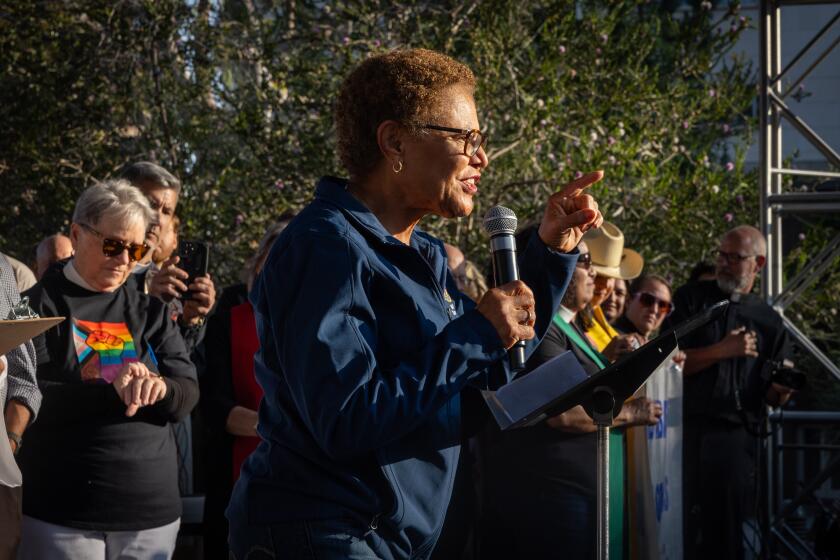Rainbow-Wise, the Big Apple Is Four Terms Behind L.A.
- Share via
Black mayoral candidate David Dinkins’ surprisingly easy 51% to 42% victory over three-term incumbent Edward I. Koch in last week’s New York City Democratic primary bears a remarkable resemblance to Tom Bradley’s victorious campaign against three-term incumbent Sam Yorty in Los Angeles’ 1973 mayoral election.
In New York, Koch’s diatribe against Jesse Jackson in the 1988 Democratic presidential primary--Jews would be “crazy” to vote for Jackson--was only the most inflammatory in a series of racial slights that worked against him in a city reeling from the racially motivated killings of blacks in Howard Beach and Brooklyn.
In contrast to the “hot” Koch, the dignified and understated Dinkins successfully portrayed himself as a “cool” healer of the city’s racial divisions, determined to end Koch’s “government by temper tantrum.” Capitalizing on the epidemic of bribes and payoffs in Koch’s third administration, Dinkins also promised better municipal management. Dinkins’ campaign slogan “Ya Basta?”--Spanish vernacular for “Had Enough?”--became Koch’s political epitaph.
In Los Angeles, “Ya Basta?” could have served as Tom Bradley’s slogan in his 1969 and 1973 races against Yorty. The verbally self-indulgent Yorty inflamed racial divisions in a city slowly recovering from the Watts riot. In his two campaigns against Bradley, Yorty was a master of racial innuendo, depicting Bradley as a fellow traveler of black militants. In sharp contrast to the fiery mayor, the low-key Bradley promised to be a racial healer. Bradley also charged Yorty with managerial incompetence.
The comparison of multiracial coalition-building in New York and Los Angeles extends far beyond these similarities between the Dinkins and Bradley campaigns. Should the favored Democrat Dinkins defeat Republican mayoral nominee Rudolph Giuliani in November (Democrats hold a 5 to 1 voter registration lead), the nation’s two largest cities will have black mayors, even though blacks do not make up the majority in either city. Blacks comprise only 25% of New York City’s population and 17% of Los Angeles’.
What is so surprising is not that black mayors can be elected with substantial non-black support but that New York trailed Los Angeles by a full generation in fielding a viable black mayoral candidate. Los Angeles’ Bradley succeeded in forging a durable rainbow coalition of blacks, Jews, Latinos and Asians without a strong Democratic Party and labor movement.
In supposedly ethnically friendly and heavily Democratic New York, however, black politicians with mayoral ambitions repeatedly failed to move beyond their black electoral base. Only Dinkins shows the belated promise of being an “East Coast Tom Bradley” by winning more than one-half the Latino vote and much more than a quarter of the Catholic and Jewish vote in the Democratic primary.
The key to rainbow coalition-building by black mayoral candidates in Los Angeles and New York lies in the relationship between Jews and blacks. Jews comprise 15% of Los Angeles’ voting population and 25% of New York’s. An alliance of blacks and Jews can be potent at the polls, representing one-third of Los Angeles’ electorate and one-half of New York’s.
Ironically, Los Angeles’ conservative downtown Establishment helped forge the black-Jewish coalition, the cornerstone of Bradley’s success, by keeping both groups out of power. In the 1960s, Los Angeles’ blacks and Jews found they had much in common politically. Outsiders to the city’s Republican power structure, they shared a liberal ideology and Democratic Party allegiance. As minority voting blocs in citywide contests (each representing one-sixth of the electorate), they had strong incentive to unite.
Things have been otherwise in New York. When blacks finally came of age politically in the 1960s, Jews were already longstanding members of the city’s liberal reform Establishment. An emerging black-Jewish alliance proved short-lived. It was wrecked by the 1968 Ocean Hill-Brownsville school conflict pitting Jewish teachers against black students and parents. The emergence of Koch in 1977 dramatically escalated black-Jewish estrangement.
Dinkins is working assiduously to repair the tattered relationship. In last week’s primary, Dinkins received more than 25% of the Jewish vote (and upward of 33%, according to some political analysts), despite running against three Jewish candidates. He has cultivated the Jewish community, denouncing Louis Farrakhan and protesting former President Ronald Reagan’s wreath-laying at Bitburg Cemetery.
Dinkins’ ability to duplicate Bradley’s under-appreciated achievement of bringing blacks and Jews together is the key to a winning ticket in November. Whatever his current troubles, Bradley’s Los Angeles, not New York’s vaunted melting pot, has been the true pioneer of multiracial politics.
More to Read
Sign up for Essential California
The most important California stories and recommendations in your inbox every morning.
You may occasionally receive promotional content from the Los Angeles Times.













